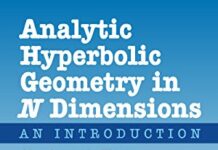
Ebook Info
- Published: 2005
- Number of pages: 484 pages
- Format: PDF
- File Size: 15.97 MB
- Authors: Abraham Albert Ungar
Description
This is the first book on analytic hyperbolic geometry, fully analogous to analytic Euclidean geometry. Analytic hyperbolic geometry regulates relativistic mechanics just as analytic Euclidean geometry regulates classical mechanics. The book presents a novel gyrovector space approach to analytic hyperbolic geometry, fully analogous to the well-known vector space approach to Euclidean geometry. A gyrovector is a hyperbolic vector. Gyrovectors are equivalence classes of directed gyrosegments that add according to the gyroparallelogram law just as vectors are equivalence classes of directed segments that add according to the parallelogram law. In the resulting “gyrolanguage” of the book one attaches the prefix “gyro” to a classical term to mean the analogous term in hyperbolic geometry. The prefix stems from Thomas gyration, which is the mathematical abstraction of the relativistic effect known as Thomas precession. Gyrolanguage turns out to be the language one needs to articulate novel analogies that the classical and the modern in this book share.The scope of analytic hyperbolic geometry that the book presents is cross-disciplinary, involving nonassociative algebra, geometry and physics. As such, it is naturally compatible with the special theory of relativity and, particularly, with the nonassociativity of Einstein velocity addition law. Along with analogies with classical results that the book emphasizes, there are remarkable disanalogies as well. Thus, for instance, unlike Euclidean triangles, the sides of a hyperbolic triangle are uniquely determined by its hyperbolic angles. Elegant formulas for calculating the hyperbolic side-lengths of a hyperbolic triangle in terms of its hyperbolic angles are presented in the book.The book begins with the definition of gyrogroups, which is fully analogous to the definition of groups. Gyrogroups, both gyrocommutative and non-gyrocommutative, abound in group theory. Surprisingly, the seemingly structureless Einstein velocity addition of special relativity turns out to be a gyrocommutative gyrogroup operation. Introducing scalar multiplication, some gyrocommutative gyrogroups of gyrovectors become gyrovector spaces. The latter, in turn, form the setting for analytic hyperbolic geometry just as vector spaces form the setting for analytic Euclidean geometry. By hybrid techniques of differential geometry and gyrovector spaces, it is shown that Einstein (Möbius) gyrovector spaces form the setting for Beltrami-Klein (Poincaré) ball models of hyperbolic geometry. Finally, novel applications of Möbius gyrovector spaces in quantum computation, and of Einstein gyrovector spaces in special relativity, are presented.
User’s Reviews
Editorial Reviews: Review ?This new book by Ungar is very well-written, with plenty of references and explanatory pictures.” From the Author Geometry is at the foundation of physics. In particular, hyperbolic geometry finds natural home at the foundation of Einstein’s special relativity theory,just as Euclidean geometry lies at the foundation of Newtonian physics. By listening to the sounds of relativistic velocities and their compositionby Einstein velocity addition law, analytic hyperbolic geometry emerges, significantly extending Einstein’s unfinished symphony.Vector addition is both commutative and associative, giving rise to vector spaces. In full analogy, gyrovector addition is both gyrocommutative andgyroassociative, giving rise to gyrovector spaces. Einstein’s addition of relativistic velocities is given by gyrovector addition, just as addition ofNewtonian velocities is given by vector addition. The resulting gyrovector spaces form the algebraic setting for analytic hyperbolic geometry, just asvector spaces form the algebraic setting for analytic Euclidean geometry.The resulting analytic hyperbolic geometry emerges in this book as a new mathematical discipline, fully analogous to the familiar analytic Euclideangeometry. As such, this book uncovers unexpected analogies with classical results, enabling the modern and unfamiliar to be studied in terms of theclassical and familiar.
Reviews from Amazon users which were colected at the time this book was published on the website:
⭐It is impossible to find another book in my entire life in science (and to this I include my early days in middle school up to my professional career today) that I found so useless!The title of the book is partly misleading. Although the book is about hyperbolic geometry, it is not about the standard tools and methods of analytic hyperbolic geometry. For his exposition, the author uses an obscure method called gyrovectors. Through them, he presents everything related to hyperbolic geometry. To persuade us about the importance of the topic he cites some comments from other people (e.g. a section from a review written on the author’s previous book and sentences from a letter written to him by a theoretical physicist.) Unfortunately, I found the entire book pointless! Students who want to learn either hyperbolic geometry or its applications to relativity will not understand anything. Notation and tools are unfamiliar. Proofs to known results without any long term benefit. For researchers, this book adds nothing to their existing methods, except perhaps another point of view. However, I am not persuaded that this new way is more effective or more fruitful. I stopped reading after a small portion of the book. Then I looked at the presentation of some well known topics and I did not reach the conclusion that I should really put an effort to understand gyrovectors. If anything, I know a few other ideas on the same topics that are by far superior and more powerful. It is possible that my evaluation of the importance of gyrovectors will prove incorrect. However, I give very low probability for this to happen. So, overall, I do not see any reason why a book on the topic is needed. The most dedicated researchers who will read the book, they could have understood the topic from the papers the author and other people have published.Before I end my review, I would like to apologize to the author for my bad review. I understand how hard is to write a book and I recognize how depressing is to see a reader being so negative and undervalue your work. However, I feel responsible to warn other unsuspected readers who may want to read/buy the book with the expectation to find established and widely known techniques. So, I would advise the author to take into account the expectations of the readers before he writes his next book. (It appears that this advise comes too late; as soon as I finished this review, I found a newer book by the author.)
⭐Group theory has held center stage in mathematics and science due to its symmetry resulting from the associative law. Nonassociative algebras were considered awkward, hard to work with, and lacking the grace found with groups. Nonassociative algebras were often confined to the sidelines while groups were showered with praise and attention.Times have changed. Nonassociative structures are finding their place alongside groups in the form of groupoids, quasigroups and loops. They are not new. They have been around since mathematicians have studied Latin squares. For those who enjoy Sudoku, you are actually playing with quasigroups. Quasigroups and loops have been shown to be useful in combinatorics, geometry, and other fields of mathematics for several decades now.Gryogroups were discovered by Abraham Ungar in 1988. It is a loop that has a structure similar to the associative law found in groups called a gyroassociative law. A primary example of a gyrogroup is Einstein’s velocity vector addition from special theory of relativity. Other gyrogroups, including finite examples, exist in the literature as well.In Analytic Hyperbolic Geometry: Mathematical Foundations and Applications, Ungar shows that what groups and vector spaces can do for Euclidean geometry, gyrogroups and gyrovector spaces can do for hyperbolic geometry. The book is self-contained. He introduces the concept of gyrogroups in the beginning chapters and is understandable to those who have knowledge of group theory from an abstract algebra course. He then moves on to developing a gyrovector space and how it can be applied to hyperbolic geometry. Finally, he applies his approach to topics in quantum mechanics and special theory of relativity.There are many books on analytic (Euclidean) geometry, a subject which is an important branch of Euclidean geometry. In full analogy, analytic hyperbolic geometry is an important branch of hyperbolic geometry. Yet, no books on analytic hyperbolic geometry are found prior to their publication by Ungar. Indeed, the lack of books on analytic hyperbolic geometry created a void that could be filled only with the new tools and techniques that Ungar introduced since 1988.This situation is well described by the renowned historian of relativity physics, Scott Walter, who wrote in his Book Review (Foundations of Physics, Vol. 32(2002), pp. 327-330): “Until recently, no one was in a position to offer an improvement on the tools available since 1912. In his [2001] book, Ungar furnishes the crucial missing element from the panoply of the non-Euclidean style: an elegant nonassociative algebraic formalism that fully exploits the structure of Einstein’s law of velocity composition.”Indeed, it is Ungar’s new tools that enable papers on analytic hyperbolic geometry to appear. So far, Ungar is the only author who has ever published a book on the subject. However, several authors have joined Ungar in writing papers on analytic hyperbolic geometry, which result from Ungar’s books on the subject.For those who are possibly interested in the book, do read the description carefully so you know what you are buying. It is probably due to a misunderstanding on the nature of the book and how it approaches the foundations of hyperbolic geometry that led to a negative review. For those who read the description of the book carefully, if offers exactly what it promises, “The book presents a novel gyrovector space approach to analytic hyperbolic geometry.”
⭐I’ve seen a technical report of Francoise Chatelin, available on the internet at google scolar, about an exciting new mathematical language crafted by Ungar.The new mathematical language is originally geared towards hyperbolic geometry, as Chatelin states. But she exported some of the resulting tools into the theory of mathematical computation. Furthermore, Chatelin states in her report that “Einstein’s intuition was left dormant for some 80 years until it was brought back to a new mathematical life in the seminal paper (Ungar 1988)”.Therefore I decided to learn more about this new mathematical language, and I started with this book. This new mathematical language enables the study of hyperbolic geometry to be guided by the common study of Euclidean geometry. Thus, for instance, as it is shown in the book, gyrovector spaces form the algebraic setting for hyperbolic geometry, just as common vector spaces form the algebraic setting for Euclidean geometry.I would strongly recommend this book for all those students and researches who are interested in the study of hyperbolic geometry and relativistic physics under the same umbrella by means of new tools and new methods.
Keywords
Free Download Analytic Hyperbolic Geometry: Mathematical Foundations and Applications in PDF format
Analytic Hyperbolic Geometry: Mathematical Foundations and Applications PDF Free Download
Download Analytic Hyperbolic Geometry: Mathematical Foundations and Applications 2005 PDF Free
Analytic Hyperbolic Geometry: Mathematical Foundations and Applications 2005 PDF Free Download
Download Analytic Hyperbolic Geometry: Mathematical Foundations and Applications PDF
Free Download Ebook Analytic Hyperbolic Geometry: Mathematical Foundations and Applications

